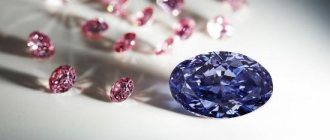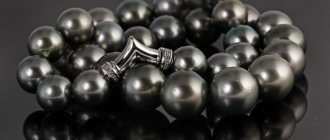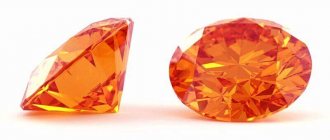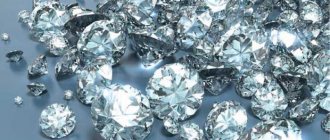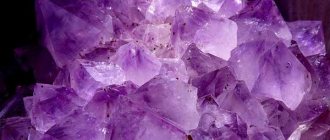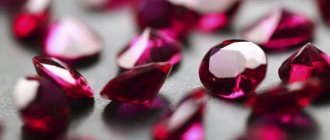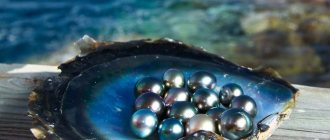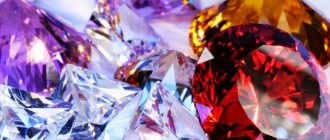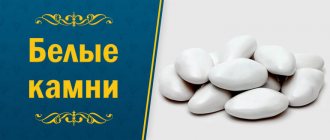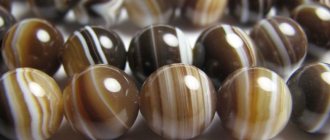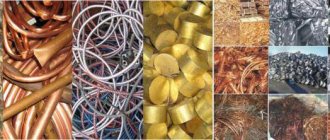Today, the jewelry industry has reached such a level that fashionable and beautiful products are made from almost any material. Conventional precious stones often fade into the background, giving way to more budget-friendly semi-precious and ornamental stones. But not all customers know how the inserts differ from each other and why prices vary so much for minerals that are similar in appearance. To understand this, let’s take a short excursion into the history of the jewelry industry and consider each type of insert separately.
Gems
The most expensive and most valuable inserts. What is the reason for the high cost of such minerals? Let's figure it out in order.
The first thing to consider is that gems are natural minerals formed in a complex way in the earth’s crust. Accordingly, a gemstone can be called such only if it is rare in nature .
Jewelry with cognac diamonds in the “Chocolate” collection
Let us present some statistical data from world practice. The relative cost of mining the most expensive stones as a percentage of the cost of total mining at the beginning of the 21st century was as follows: emeralds - 43, rubies - 14, opals - 10, sapphires - 6, jadeite - 6, turquoise - 5, other colored stones - 16%. This shows that the high cost of precious stones is due, first of all, to the complexity of their extraction.
What other indicators can identify a gemstone among all the others?
Hardness _ The mineral should not be exposed to external influences - scratched or chipped. In Russia, in accordance with the Federal Law “On Precious Metals and Precious Stones,” this list includes natural diamonds, emeralds, rubies, sapphires, alexandrites, and pearls. Unique amber formations are also considered precious stones. From this we see that its high cost is quite understandable.
In addition, the degree of its fashionability . Simply put, the more an accessory falls under the definition of a “fashion trend,” the higher its cost.
The world of precious stones is very large and, unfortunately, confusing, especially when viewed superficially. At the moment, over 2.5 thousand minerals are known, but only a little more than a hundred of them are valuable from the point of view of the jewelry industry and decorative arts.
It is quite difficult to understand the intricacy of varieties of precious, semi-precious and ornamental stones, but there are also valuable natural formations that are not minerals. Therefore, within the framework of this publication, several approaches to the classification of valuable minerals and natural formations will be considered.
Blue Garnet
0
Blue garnet is the rarest of these minerals and was first discovered in Madagascar only in the late 1990s. Today, stones of this color are found in Tanzania, Sri Lanka, Kenya, Norway and the USA. Their main distinguishing feature is the ability to change their shade when the lighting changes. So in daylight they acquire blue, indigo and green tints, and in artificial light they become purple or red. Today, the average cost of this high-quality gemstone is 1,500 USD. per carat
What types of gems are there?
The names of precious stones and minerals (which, in fact, are the same thing) are presented differently in different classifications, since a unified system has not yet been developed. From a generally accepted point of view, only the most beautiful, rare and expensive minerals and other natural formations can be considered precious stones.
According to Article 1 of the Federal Law of March 26, 1998 No. 41-FZ, officially precious stones are exclusively diamonds, rubies, emeralds, alexandrites and sapphires, as well as pearls of natural origin, that is, organics. Amber is also sometimes included here, but with certain unique features - special inclusions, heavy weight, and so on.
Ring from the “Diamonds of Yakutia” collection in Sunlight
However, there are also nuances here: precious stones in jewelry look very impressive and cost accordingly. But very small or defective minerals lose a lot in value, while semi-precious semi-precious gems of large sizes and rare colors can be equal in value to first-order precious stones.
The science that studies precious stones is called gemology. This is a special section of mineralogy devoted to precious, jewelry, semi-precious and ornamental stones.
Table of precious stones according to the classification of the prominent Soviet and Russian mineralogist E.Ya. Kievlenko seems the most logical and easy to understand. Based on it in the light of modern realities, Doctor of Geological and Mineralogical Sciences E.P. Melnikov proposed an improved version of the classification.
Without going into detail, there are four groups of valuable minerals:
- Gems. Diamond, classic blue sapphire, ruby, alexandrite, emerald and natural sea pearls.
- Jewelry stones. They are divided into four orders. Among the most famous: sapphires of fancy colors, spinel, opals, tanzanite, various types of beryl and corundum (except precious ones), tourmalines, zircons, garnets, freshwater and sea cultured pearls, amethyst, aquamarine, citrine, tiger and cat's eye, apatite, mother of pearl, certain types of quartz and others.
- Jewelry and ornamental stones. Malachite, turquoise, jadeite, lapis lazuli, pink and smoky quartz, jasper, ordinary opals, rock crystal, special grades of jasper, jade, agate, chrysoprase and others.
- Ornamental stones. Jasper, marble onyx, jet, goldite, obsidan, certain types of granite and other ornamental materials of mineral origin.
In addition to pearls, the classifier also includes other materials of organic origin. These are corals, mammoth and ivory. They are considered jewelry and ornamental stones.
Musgravit
0
Musgravite is a close relative of taaffeite, to which it is similar in appearance and chemical composition. It was first discovered in 1967 in Australia's Musgrave Range. Later, the mineral was found in Greenland, Tanzania, Madagascar and even in the depths of the cold lands of Antarctica. This gem comes in several colors, but the most common are green and purple. Due to the fact that very small quantities of these precious stones have been found throughout history, their price reaches quite expected levels: the cost of a carat of high-quality green musgravite is 2-3 thousand dollars, while for one carat of a purple faceted mineral you will have to pay about 6 thousand conventional units.
The most expensive gems
We will not repeat the above: the most expensive in the ranking of precious stones in terms of value are the last five positions described above. These are gems of the first order and the highest value according to any classification.
But you need to understand that it is impossible to compile an objective list of stones by value: the cost of a carat of a mineral depends not only on its chemical formula, but also on purity, transparency, size, color, presence/absence of defects and other parameters.
Therefore, in this nomination we will present the rarest and most expensive minerals that go beyond generally accepted standards. So, here is a list of truly unique stones, valued at fortunes:
- Tsavorite. Jewelry garnet is yellowish-green in color. A carat costs about 3-5 thousand US dollars.
- Sapphire. An unheated stone of pure blue color is estimated at a minimum of 4.5-6 thousand dollars/carat.
- Red spinel. It is considered one of the fastest growing minerals in price: the cost is 6-8 thousand dollars per carat.
- Demantoid. Another green garnet, but a piercing pure color. Ural demantoid costs about 10 thousand dollars/carat.
- Paraiba. Neon blue tourmaline that glows in the dark. Average quality stones cost 8-12 thousand dollars/carat.
- Emerald. Flawless pure emeralds are extremely rare. The cost of a carat of high-quality unoiled emerald starts from 10-13 thousand dollars
- Padparadscha. The sapphire is an incredible orange-pink color. Cost – 10-12 thousand dollars/carat.
- Alexandrite. The price of this stone ranges from 10-37 thousand dollars/carat. The most expensive are those mined in Russia.
- Ruby. A clean large stone of the top color “pigeon blood” is estimated at 15-25 thousand dollars/carat.
- Jade. The rarest transparent jadeite, known as “imperial”, costs at least 20 thousand dollars per carat.
- Diamond. The cost of a high-quality colorless diamond is about 15 thousand dollars per carat. A blue diamond costs about 30-50 thousand. And the most expensive gemstone in the world is the red diamond: a carat is estimated at 500 thousand - 1 million dollars.
Paraiba Tourmaline
Poudretteite / Poudretteite
0
Poudretteite / Poudretteite is a rare pink mineral first discovered in 1987 in Quebec, Canada. It got its name in honor of the Poudrette family, which still owns the same mine in Mont Saint-Hilaire where the first sample was found. Quality stones only began to appear in 2000, when several specimens were found in northern Mogog (Myanmar). Since 2005, the mineral has not been discovered there, and the Canadian deposit has given the world only about 300 stones of varying quality. Depending on the color saturation and purity, the cost of poudretteite can range from 3 to 5 thousand conventional units.
What is the difference between precious and semi-precious
There are no objective parameters that distinguish precious stones from semi-precious ones. The main criterion in this case is the price: semi-precious ones are inexpensive, precious ones are not accessible to everyone.
In the classification of the All-Russian Research Institute of Jewelry Industry there is no concept of precious and semi-precious stones at all: they can be jewelry, semi-precious and jewelry-precious.
Precious stones mined in Russia are highly valued on the world market. Moreover, the Russian Federation has deposits of almost all precious minerals, with the possible exception of rubies.
Diamond
0
Diamond is a common mineral and has long been one of the most expensive and desirable gemstones. The reason for this, of course, is the enormous popularity of diamonds (as cut diamonds are called). Every year the number of manufactured jewelry with these precious stones is rapidly increasing. Industrial diamond deposits are now known on all continents except Antarctica. Currently, a perfectly cut D color diamond sells on average for about 15,000 USD. e. per carat.
Classification of stones by properties
The classification of precious stones takes into account all kinds of physical, optical and other characteristics. The most obvious characteristic of gemstones is their weight. With all other qualities being equal, a carat of a large mineral will cost more than a similar unit of a small one (sometimes by several times).
Carat is a unit of weight of precious stones, accepted by jewelers all over the world. One carat is only 0.2 grams!
All other properties of precious stones can be combined into the following broad groups:
- Rarity. The rarer the mineral, the higher its value. It’s enough for a large deposit to be depleted, and the stone immediately soars in price.
- Feeling. Tactile sensations when touched (“soapiness”, slipperiness, etc.).
- Density. The denser the stone, the heavier it is. Zircon is even heavier than diamond. The lightest is amber.
- Hardness. Here it is appropriate to mention the Mohs scale, which grades the hardness of substances according to a ten-point system, from diamond (10) and corundum (9) to talc. Test - surface scratching.
- Strength. A very hard stone may not be very durable and will easily crack under physical stress. Not too hard jade is very difficult to split due to its high viscosity, and zircon crumbles instantly.
- Cleavage. The description of this characteristic is quite difficult: it is the “behavior” of the stone when splitting (in which directions it splits). It is fundamentally important when cutting.
- Electrification and polarity. For the jewelry industry, these parameters are not important.
- Transparency. Gemstones are usually transparent or translucent. The purer the stone, the more valuable it is.
- Color. Multi-colored stones can be more valuable or cheaper than their classic counterparts. Examples were given above.
- Shine. Can be diamond, glass, silky, mother of pearl and so on.
- Light refraction. A characteristic that is fundamentally important when choosing a cut.
- Dichroism and polychroism. The ability of a stone to change color depending on the angle and intensity of light.
- Asterism. The effect of a “star” inside the stone when hit by light.
- Luminescence. The ability to glow, characteristic of diamonds, rubies, jade and other stones.
- Defectiveness. Presence, location, type and number of various defects.
- Quality of cut. The value of the mineral directly depends on the quality of the cut.
- Ennoblement. A stone with good natural characteristics will always cost more than its improved (heated, oiled, painted, etc.) counterpart.
Types of cuts
Its brilliance and the play of light on the surface largely depend on the cut of a gemstone. Cutting refers to the technique of processing a mineral, upon completion of which a certain shape of a stone is formed with a certain number of faces, their location, proportions relative to each other and characteristic outlines. Let's look at the most commonly used types of cuts:
Round cut
Number of faces: 17, 33, 57
The round cut is something of a classic. The history of this cut goes back more than a hundred years. It is perfect for diamonds, as it collects and enhances the shine of the stone. In addition, the round cut protects the gemstone from chips and other damage. The lighter the stone (the smaller the carat), the fewer facets the jeweler will carve. Fly in the ointment - with this cut, up to 50% of the original weight of the gem is lost.
Oval cut
Number of faces: 57
This option for cutting stones has been known since the 60s of the 20th century. The “oval” cut has a more elongated shape than the round cut; and allows the stone to play with iridescence in the light. Gems cut into oval shapes are often used in rings to visually lengthen the fingers.
Marquise cut
Number of faces: 55
The Marquise cut is similar to a boat and is an oblong oval with pointed corners at the edges. As with the oval cut, the marquise cut on the ring elongates the fingers. However, be aware that the sharp wedges at the ends of the stone will become vulnerable and brittle.
Drop cut (Pear)
Number of faces: 55-56
The “Drop” combines the features of the “Marquise” and “Oval” cuts - on one side the gem will have a rounded end; and on the other hand, it’s spicy. The sharp end acts as a vulnerable point of the gemstone, prone to cracks. Therefore, experienced jewelers try to protect it with a frame. A teardrop-shaped cut of a gem in a necklace or necklace will advantageously lengthen the neck.
Princess cut
Number of edges: 49, 65,68
The “Princess” has a square or more often rectangular shape. Like the round cut, the Princess cut maximizes the brilliance and brilliance of the gem. In addition, when choosing this cut, the nugget will lose less of its original weight. This cut is often used for engagement ring diamonds. Like any other sharp corners, the tops of the “Princess” must be reliably protected by the frame.
Cabochon
Cabochoning is a method of processing stone to give it a rounded, convex shape (sometimes flat on one side). Most often, this cutting method is used when processing impenetrable or low-permeability stones; as well as stones that have any optical effects (for example, asterism or opalescence).
How to distinguish precious stones from artificial analogues
Artificial gemstones have the same composition as their natural counterparts. Moreover, they are, as a rule, of higher quality and purer than their natural counterparts. Various valuable crystals are grown under artificial conditions: diamonds, emeralds, rubies and others like them.
However, synthetic stones are much cheaper than natural ones (sometimes hundreds or even thousands of times). And this is explained by the fact that people tend to want to own something especially exclusive.
Almost all minerals remain cool for a long time. A fake made of glass or plastic quickly heats up in your hands. In this way, it is impossible to distinguish a precious stone from a non-precious one, but a crude imitation will immediately give itself away.
You need to understand that synthetic minerals are not fakes, that is, imitations (double stones or ordinary glass). If you buy a product in a large jewelry store, the chance of purchasing an artificial analogue or imitation without knowing it is surely close to zero. They simply won’t risk their reputation.
Gold ring with synthetic amethyst
Gold ring with natural amethyst
A non-professional will not be able to determine whether a gemstone is precious or not simply by eye. It is best to beware of buying jewelry second-hand or from small, dubious shops.
But if you somehow get your hands on a dubious specimen, an examination and evaluation of stones is at your service, which can be ordered at any jewelry workshop. Gross fakes are identified immediately, visually; in complex cases, more specific methods are required.
LiveInternetLiveInternet
Wednesday, April 17, 2013 21:02 + in quote book Precious stones are a large group of various stones of mineral and organic origin. The properties that determine the dignity of a precious stone include: the beauty of the stone, color, various colors and shades, shine, transparency, play of light and the hardness of the stone, which determines its durability and ability to maintain its shape without changing under mechanical stress. There are different classifications of stones. However, the most widely used classification is developed by the Soviet professor E. Ya. Kievlenko. According to this classification, all stones are divided into three groups: jewelry or precious stones, jewelry and semi-precious stones, semi-precious stones. In these groups, the stones are arranged in order of their value on the world market. The first group is divided into four orders: I - diamond, ruby, emerald, blue sapphire II - alexandrite, orange, purple and green sapphires, noble black opal, noble jadeite III - demantoid, spinel, noble white and fire opal, topaz, aquamarine, rhodolite, tourmaline, moonstone, IV - peridot, zircon, yellow, green and pink beryl, turquoise, amethyst, citrine The second group is divided into two orders: I - lapis lazuli, amber, rock crystal, jade, jadeite, malachite II - agate, opal, rhodonite, amazonite, rose quartz, heliotrope, cacholong The third group has no divisions. These are mainly decorative facing stones. It includes: jasper, written granite, petrified wood, marble onyx, jet, selenite, patterned flint, jaspilite, fluorite, obsidian, colored marble. Background information on the most common gemstones. DIAMOND Diamond (from the French “brilliant” - brilliant) is a transparent artificially cut diamond. This is the hardest stone in the world. The hardness of the stone on the Mohs scale (stone hardness scale) is 10. It is not for nothing that the Arabs called it “almas”, which means “the hardest”. Diamond is the most valuable among all jewelry stones. Not a single stone can compare with it in the brightness of its shine and shimmer of all the colors of the rainbow. Diamonds are graded according to the “4 C” system: cut - cut, clarity - purity, color - color, carat - weight in carats. The largest and most expensive diamond in the world, the Cullinan, was found in 1905 in South Africa. "Cullinan" adorns the top of the royal scepter of Great Britain. Its value is equal to the cost of 94 tons of gold. RUBY Ruby (from the Latin “rubens”, “rubinus” - red) is a transparent red modification of corundum (aluminum oxide). Ruby is the second hardest stone after diamond. The hardness of ruby on the Mohs scale is 9. The red color is given to it by the addition of chromium oxide. The color ranges from dark red to light red. The best rubies are fiery red or dark red in color. Rubies of high quality, without defects, are very rare and cost much more than diamonds of the same mass. The largest uncut Raja Ratna ruby weighs almost half a kilogram (459 g), which is 2,475 carats. The cost of rubies weighing up to 400 carats ranges from $600,000 and above. Large deposits of rubies: Pamir, Ural, Burma, Thailand, Sri Lanka, and East Africa. SAPPHIRE Sapphire (from the other Greek “sappheiros” - blue) - like ruby, is a transparent variety of corundum. The hardness of the stone on the Mohs scale is 9. Sapphire has the same properties as ruby, but its color is due to the admixture of iron and titanium oxides. Sapphire is known as a blue mineral. However, there are sapphires in blue, purple, yellow, green and even pink. Sapphire is a very hard mineral; only a diamond can scratch it. Therefore, it is perfect for jewelry. Sapphire is one of the four most expensive stones in the world. It is found more often than ruby, and often in the form of large stones. The most expensive sapphires are dark blue and cornflower blue. Large deposits of sapphires are considered to be: India, USA, Vietnam, Australia, Burma, Brazil, China, Sri Lanka. The cost of sapphires ranges from $200 to $5,500 per carat. EMERALD Aquamarine (from the Latin “aqua marina” - sea water) is a pale blue variety of beryl. Greenish-blue, blue-green and colorless aquamarines are also found. Hardness on the Mohs scale is 7.5-8. Aquamarine is the most common mineral in nature. Main deposits: Brazil, Russia, Australia, South Africa, Sri Lanka, USA, Mozanbeque. The largest aquamarine was found in Brazil in 1910. The cost of aquamarine is relatively low. $20-200 per carat. The most prized aquamarines are those with a deep blue-green color. ALEXANDRITE Alexandrite is a variety of chrysoberyl. It has the rare property of changing color. In daylight, the stone changes color from dark blue to emerald green, and in artificial light from pink-crimson to red-violet. The hardness of the stone is 8.5 on the Mohs scale. Alexandrite should be worn in pairs, that is, have a set of alexandrite jewelry. Alexandrite is found in the Urals, Sri Lanka, and Brazil. The cost of alexandrite varies from $5,000 to $30,000 and above. However, their price depends on color, purity and weight. The name “Alexandrite” was given to the mineral in 1842 in honor of the heir to the Russian throne, Alexander II. AMETHYST Amethyst (from the Greek “amethystos” - inebriated) is a semi-precious stone that belongs to the quartz group. It is a transparent mineral ranging from almost colorless, pale violet, bluish violet, dark violet, almost black. The purple color is due to iron contamination. Dark purple amethysts are considered the most expensive. The hardness of amethyst on the Mohs scale is 7. Amethyst can withstand high temperatures. When heated to 200-300 °C, the stone completely loses its purple color. But then, as the amethyst cools, it returns to its previous color. I meet amethysts in the Urals and are considered the best in the world, Brazil, Uruguay, Saxony, Madagascar. In nature, this mineral occurs in the form of elongated crystals. The cost of amethyst is $2-20 per carat. TURQUOISE Turquoise (from the translation “firuza” - stone of happiness or “piruz” - winning) is an aqueous hydrated phosphate of aluminum and copper. It is an opaque stone with an amphora structure in sky blue, bluish blue, bluish green, apple green. Turquoise is also found with spotted colors and brown stripes. The most highly valued turquoise is sky blue. The hardness of turquoise on the Mohs scale is 5-6. Large deposits of turquoise are Iran, Afghanistan, Tajikistan, Uzbekistan, Turkmenistan, Egypt, USA, Australia, Argentina. The price of turquoise is about $10 per carat. Turquoise has always been a popular stone and is highly prized. Used as inserts in jewelry and beads. For Muslims, turquoise is a mandatory element of a bride's wedding dress. Rings with turquoise were traditionally exchanged on the day of engagement. ROCK CRYSTAL Rock crystal is a transparent, colorless variety of quartz. The hardness of the mineral on the Mohs scale is 7. Pure, defect-free crystals are very rare in nature and are more valuable. Rock crystal is very cold to the touch; in ancient times it was considered petrified ice. Due to its hardness and beauty, it has been used very widely since ancient times. This mineral is found frequently in nature. The main deposits of rock crystal are: Pamir, Crimea, Ural, Swiss Alps, Brazil, China. The cost of rock crystal is $2 - $6 per carat. GARNET Garnet (from the Latin “granatus” - grain, grain) is a mineral consisting of silicic acid and metal oxides. The shape resembles pomegranate seeds, hence the name. The hardness of the stone on the Mohs scale is 6 - 7.5. There are different types of garnet: Pyrope - dark red garnet (cost $12-50 per carat); Rhodolite - pinkish-red garnet (cost $12-60 per carat); Almandine - blood-red or pinkish-red garnet (cost $12-50 per carat); Demantoid - bright green garnet (the most expensive, costing $25-100 per carat); Spessartine is an orange garnet with a reddish-brown tint; Uvarovite - emerald green garnet; Grossular - apple green garnet; Hessonite - honey-orange garnet; Topazolite - bright yellow garnet; Andradite - red, brown, yellow garnet; Pereneite is a blackish-brown garnet; Rotofit - yellow-brown garnet; Leucogranate is a colorless garnet; Melanite - black garnet. Garnet is relatively unburned, but in beauty it is not nearly inferior to ruby or emerald. The main deposits of garnet are: Russia, Ukraine, Canada, USA, Brazil, Madagascar. JADEITE Jadeite is a silicate of sodium and aluminum, a green mineral in composition similar to jade. It also comes in white, yellow, black, red and blue. Jadeite is much harder than jade. Hardness on the Mohs scale 6.5 - 7. Extremely viscous. Rarely found in nature. There are only two dozen deposits of jadeite. These are mainly: China, Japan, Guatemala, Russia. The cost of jadeite is 5 - 115 $ per carat. PEARL Pearl is a mineral of a class of organic compounds, round or irregular in shape. It is formed in the shells of smallmouths, as a result of the deposition of layers of aragonite (calcium carbonate) around a foreign body, most often a piscina. Next, mother-of-pearl is deposited around the object, which in its chemical composition is calcium carbonate with a mixture of organic substances. The composition of mother-of-pearl also includes iron, copper, zinc, titanium, manganese, narthium, and silicon. The word pearl comes from the Chinese “zhenju”, from the Arabic “zechug”. Pearls can come in a variety of shades: white, yellow, gray, brown, pink, purple, red, black, green and blue. The most highly valued pearls are white, pink and black with a silver tint, as well as green and blue. It takes less than 30-40 years to grow one pearl with a diameter of 8 mm. The size ranges from microscopic to the size of a pigeon egg. The larger the pearl, the more expensive it is. The hardness of pearls on the Mohs scale is 3.5-4.5. Pearls are mainly mined in the Red Sea, the Persian Gulf, Japan, and Sri Lanka. Freshwater pearls are mined in Russia, Germany, the USA, and China. Pearls are undoubtedly a feminine accessory. Jewelry made from natural pearls is considered one of the most expensive. The cost of pearls ranges from $275 to $26,400. The world's largest pearl was found in 1934 on the island of Palovan in the Philippines. A Muslim who acquired the pearl as his property saw a head in a turban in it and called it “the pearl of Allah.” The diameter of the pearl is 238 millimeters, weight is 6,400 g or 1,280 carats. This pearl was valued at $40 million. However, pearls are not durable. Over time it fades. To prevent pearls from aging, they must be worn and should not be left in the bright sun. MOONSTONE Moonstone (adularia) is a translucent bluish-silver spar. Rare mineral. It got its name due to its mother-of-pearl sheen with a blue or soft bluish tint, reminiscent of moonlight in a soft milky color. There are also stones of light yellow color. Hardness on the Mohs scale 6 - 6.5. The main deposits of moonstone are located in India, the USA, Burma, Australia and Brazil. However, the best are considered to be moonstones from Sri Lanka. JADE Jade (from the Greek “nephros” - kidney) is a hydroxysilicate of calcium, magnesium, iron. It comes in a variety of colors: yellow, red, gray, honey, black, but the most common is jade green. A characteristic feature of jade is the depth and softness of tone. The hardness of the stone on the Mohs scale is 5.5-6.5. Jade is a sacred stone for the Chinese. The cost of the stone is 6-7 $. Jade is found in China, the Pamirs, the USA, Canada, and also in New Zealand. OPAL Opal (from the Sanskrit “upala” - precious stone) is a mineral, a type of silicon dioxide with small admixtures of iron oxide, alumina, and lime. The color of the mineral can be red, blue, yellow, green, pale milky and even black. Opal is a very fragile stone. On the Mohs hardness scale 5.5-6. The best opals are light pink and golden in color. Opals are found in Hungary, Brazil, Australia, Mexico, and Guatemala. A very large opal was found in a corn field in Brazil. Its weight reached 4,300 g (21,500 carats) and was valued at $60,000. There are several types of noble opal: Hyalite - white, transparent opal; Fiery - wine-yellow or red; Irisopal - brown opal; Girazol - blue or colorless opal; Cacholong - milky white opal; Peruvian - orange or bluish-green opal; Prazopal is an opaque apple green opal. Opal prices range from $10 to $100 per carat. TOPAZ Topaz (from the Sanskitic “tapas” - fire, flame, heat) is a semi-precious stone, an aluminum fluorosilicate mineral. Topazes have a wide variety of color shades. They can be blue, yellow, pink, light red, golden, greenish, violet, purple, brown, and also colorless. The hardness of the stone is 8 on the Mohs scale. It has a glassy luster and shimmers like mother-of-pearl. The most valuable are blue, golden and pink topazes. Rich deposits of topaz are located in the Urals, Siberia, Brazil, Ukraine, and Sri Lanka. Topaz is used in jewelry, although it is very difficult to process. Topaz can be very large. Thus, in Ukraine in 1965, a wine-yellow topaz weighing 117 kg and 82 cm high was found. The cost of topaz ranges from $2 to $40 per carat. TOURMALINE Tourmaline (from the Senegalese “turamali” - multi-colored) is a brittle stone belonging to boroaluminosilicates. The hardness of the mineral on the Mohs scale is 7. The range of shades of tourmaline is varied: Agnites - purple; Apirites are pink in color; Achrontas are colorless; Verdelite - green shades; Dravite - brown; Indigolites are blue; Rubellites are cherry-red in color; Shirley is black. Tourmalines are found in Russia, Brazil, Sri Lanka, Canada, Burma, USA, India and Afghanistan. Tourmaline has beneficial properties that are used in microelectronics and medical devices. The cost of tourmaline ranges from $50 to $700 per carat. CITRINE Citrine (from the Latin “citrus” - lemon yellow) is a semi-precious stone, a type of quartz. Color from light lemon to amber. Transparent mineral. Rarely found in nature. Citrine is sometimes called “golden topaz.” This is due to the fact that when cut, the color of topaz and citrine is the same. Citrine is a hard mineral, but compared to topaz it is softer and has less shine. Hardness on the Mohs scale is 7. The main deposits of citrine are: Brazil, Spain, France, USA, Russia, Kazakhstan. AMBER Amber is a fossil resin, an organic mineral. Amber contains carbon, hydrogen, oxygen and small amounts of sulfur and ash. There are different shades of amber: from pale yellow to bright golden. Amber is an amphora mineral, that is, it does not have a crystalline structure. Amber is a very fragile stone. The hardness of the stone on the Mohs scale is 3 - 4. Amber is flammable. The main part of amber production (about 70%) occurs in Russia and the Baltic states. The cost of the stone is 60 - 350 $ per kg.
| Categories: | it needs to be beautiful |
Tags:
gemstones topaz amethyst emerald jade lapis lazuli pearl
Cited 3 times
Like share
0
Like
- I liked the post
- Quoted
- 0
Saved
- Add to quote book
- 0
Save to links
Liked
0
Interesting facts about gemstones
And now some fun facts:
- The rarest gemstone in the world is grandidierite. At the moment, only eight copies are known.
- One of the most impressive collections of precious stones in the world is the Diamond Fund in the Kremlin Armory, in Moscow.
- The hardest gemstone is, naturally, diamond. It is the hardest naturally occurring substance on Earth.
There are not so many deposits of precious stones in nature, these minerals are expensive, and not everyone can afford such luxury. Don’t be upset about this: only an expert can distinguish an artificial diamond or emerald from its natural counterpart. In addition, many semi-precious stones in a classy design look no less advantageous than prohibitively expensive top-end gems.
15.02.21
Pricing for stones from our collection
Constantly monitoring the global stone market, we operate with the most current data, and the network of our international partner dealers allows us to find unique samples at the best prices. This means that the stones from our collection are a balanced combination of quality and cost. It is also important to note that we do not focus on Russian prices for individual colored stones, because they are often many times higher. In our pricing, we rely only on world prices for stones, current global demand and the latest information on the state of deposits. We are happy to share our forecasts with you, talk about market trends and all the subtle nuances that affect the value at the moment.
